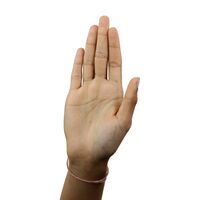Difference between revisions of "Pataka"
Jump to navigation
Jump to search
(Created page with "{{Infobox mudra | mudra = Pataka | image_name = Pataka.jpg | meaning = Flag }} '''Pataka''' Category:Mudras") |
(Description and Application) |
||
| Line 5: | Line 5: | ||
}} | }} | ||
| − | '''Pataka''' | + | '''Pataka''' is one of the simplest and most versatile gestures in dance. The "flag hand" was applied to this mudra, when Brahma went to Parabrahma to salute him with his hand held to represent a flag and to symbolize victory. |
| + | |||
| + | ==Application== | ||
| + | |||
| + | Used in many Indian dance styles, it can also be used to represent the following: | ||
| + | |||
| + | * Varivahay ("rain clouds") | ||
| + | |||
| + | * Bhana ("forest") | ||
| + | |||
| + | * Amaramandala ("heaven") | ||
| + | |||
| + | * Vayu ("wind") | ||
[[Category:Mudras]] | [[Category:Mudras]] | ||
Latest revision as of 12:40, 6 July 2013
| Meaning | Flag |
|---|---|
Pataka is one of the simplest and most versatile gestures in dance. The "flag hand" was applied to this mudra, when Brahma went to Parabrahma to salute him with his hand held to represent a flag and to symbolize victory.
Application
Used in many Indian dance styles, it can also be used to represent the following:
- Varivahay ("rain clouds")
- Bhana ("forest")
- Amaramandala ("heaven")
- Vayu ("wind")
